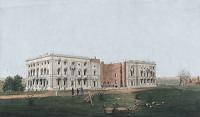
|
| Conflict | War of 1812 | | Date | June 18, 1812 � February 18, 1815 | | Location | Eastern and Central North America, Atlantic and Pacific | | Result | Treaty of Ghent
Status quo ante bellum | United States
Choctaw
Cherokee
Creek allies | British Empire British Empire
*UK United Kingdom
*UK the Canadas
Shawnee
Creek Red Sticks
Ojibway
Chickamauga
Fox
Iroquois
Miami
Mingo
Ottawa
Kickapoo
Delaware (Lenape)
Mascouten
Potawatomi
Sauk
Wyandot | United States James Madison
United States Henry Dearborn
United States Jacob Brown
United States Winfield Scott
United States Andrew Jackson
United States William Henry Harrison
United States William Hull | UK Lord Liverpool
UK George Prévost
UK Isaac Brock
UK Roger Hale Sheaffe
UK Gordon Drummond
UK Robert Ross
UK Edward Pakenham
UK Charles de Salaberry
UK Tecumseh | United States United States
•Regular Army:
- 7,000 (at start of war);
- 35,800 (at war's end)
•Rangers: 3,049
•Militia: 458,463 *
•United States Navy,
U.S. Marines, and
Revenue Cutter Service
(at start of war):
- Frigates: 6
- Other vessels: 14
Native allies:
- 125 Choctaw,
- (unknown others) |strength2=UK British Empire
•British Army:
- 5,200 (at start of war);
- 48,160 (at war's end)
•Prov. regulars: 10,000
•Provincial Militia: 4,000
•Royal Navy and
Royal Marines:
- Ships of the line: 11
- Frigates: 34
- Other vessels: 52
•Provincial Marine ‡ :
- Ships: 9 (at start of war)
Native allies:
- 10,000 | UK British Empire
•British Army:
- 5,200 (at start of war);
- 48,160 (at war's end)
•Prov. regulars: 10,000
•Provincial Militia: 4,000
•Royal Navy and
Royal Marines:
- Ships of the line: 11
- Frigates: 34
- Other vessels: 52
•Provincial Marine ‡ :
- Ships: 9 (at start of war)
Native allies:
- 10,000 | 2,260 killed in action.
4,505 wounded.
15,000 (est.)
died from all causes. | 1,600 killed in action.
3,679 wounded.
3,321 died from disease. |
|
|
The War of 1812 was a military conflict fought between the forces of the United States of America and those of the British Empire. The Americans declared war in 1812 for several reasons, including a desire for expansion into the Northwest Territory, trade restrictions because of Britain's ongoing war with France, impressment of American merchant sailors into the Royal Navy, British support of American Indian tribes against American expansion, and the humiliation of American honor. Until 1814, the British Empire adopted a defensive strategy, repelling multiple American invasions of the provinces of Upper and Lower Canada. However, the Americans gained control over Lake Erie in 1813, seized parts of western Ontario, and destroyed the dream of an Indian confederacy and an independent Indian state in the Midwest under British sponsorship. In the Southwest General Andrew Jackson destroyed the military strength of the Creek nation at the Battle of Horseshoe Bend. With the defeat of Napoleon in 1814, the British adopted a more aggressive strategy, sending in three large invasion armies. British victory at the Battle of Bladensburg in August 1814 allowed the British to capture and burn Washington, D.C. American victories in September 1814 and January 1815 repulsed all three British invasions in New York, Baltimore and New Orleans.
The war was fought in three theaters: At sea, warships and privateers of both sides attacked each other's merchant ships. The British blockaded the Atlantic coast of the U.S. and mounted large-scale raids in the later stages of the war. American successes at sea were characterized by single ship duels against British frigates, and combat against British provincial vessels on the Great Lakes, such as at the action on Lake Erie. Both land and naval battles were fought on the frontier, which ran along the Great Lakes and Saint Lawrence River. The South and the Gulf coast saw major land battles in which the American forces destroyed Britain's Indian allies and repulsed the main British invasion force at New Orleans. Both sides invaded each other's territory, but these invasions were unsuccessful or temporary. At the end of the war, both sides occupied parts of the other's territory, but these areas were restored by the Treaty of Ghent.
In the U.S., battles such as the Battle of New Orleans and the earlier successful defense of Baltimore (which inspired the lyrics of the U.S. national anthem, "The Star-Spangled Banner") produced a sense of euphoria over a "second war of independence" against Britain. It ushered in an "Era of Good Feelings" in which the partisan animosity that had once verged on treason nearly vanished. Canada also emerged from the war with a heightened sense of national feeling and solidarity, having repelled multiple American invasions. Battles such as the Battle of Queenston Heights were used as such examples by Canadians. The war is scarcely remembered in Britain today, as it regarded the war as a sideshow to the much larger war against Napoleon raging in Europe; as such it welcomed an era of peaceful relations and trade with the United States.
|
|
|




 RSS
RSS